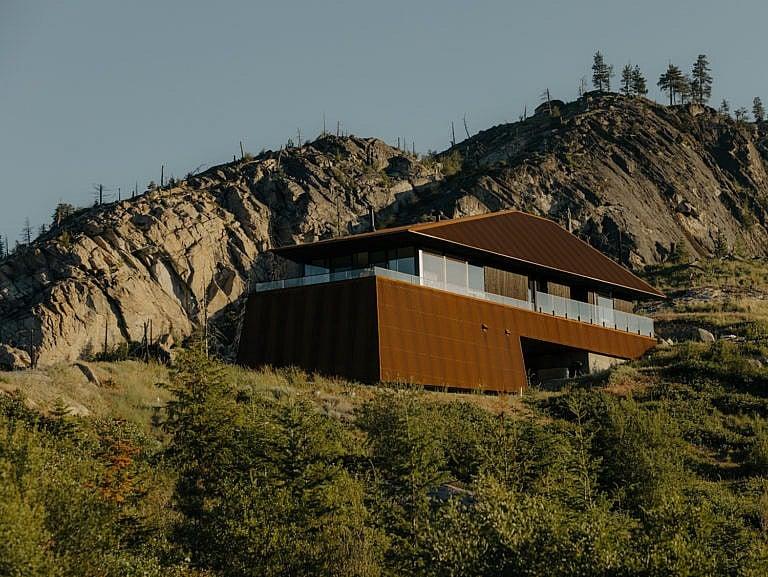This remote, fire-resistant Okanagan home was modelled after the mountain beetle
“We didn’t want to wreck the environment with a mansion—we wanted it to remain wild”

(Photography by Grant Harder)
Share

In the summer of 2003, lightning struck Okanagan Mountain Provincial Park 25 kilometres north of Penticton, B.C. Flames scorched nearly every tree in the park and travelled north and east, devouring 25,000 hectares and displacing more than 27,000 people. Twenty years later, the charred trunks left over from that firestorm form the backdrop of Paul and Tina Schlotfeldt’s home. “It’s rougher than a bear’s bum out here,” Paul says.
Paul, a geological engineer, and Tina, a retired tax consultant, bought the remote plot of land on the park’s border, high above Okanagan Lake, in 2018. They’d been living in Squamish, B.C., and took trips to the Okanagan to mountain bike and rock climb. Ready to move away from the lower-mainland crowds, they asked a realtor to show them a few Okanagan lots where they could build their own home.
She first brought them to a cheaper parcel of land lower on the mountain. It wasn’t for them, but they hiked to the uppermost lot, which was out of their budget, to have a look anyway and to take in the view of the lake snaking its way south through rugged, pine-dotted mountains. “We sat on a rock and looked down the valley, then looked at each other and went: ‘We’d be insane not to buy this.’”

They purchased the 12-acre parcel for over $300,000 and set up a trailer while they figured out what to build on the extreme terrain. Creating a home that respected the landscape was a priority. “We didn’t want to wreck the environment with a mansion,” says Paul. “We wanted it to remain wild.”
RELATED: Habitat: A mid-century sanctuary by Ontario’s Chandos Lake
Safety was also a concern. In 2018, when they bought the place, the province had 2,000 fires. This year has been one of the worst wildfire seasons in Canadian history, with experts predicting even more fires as climate change creates drier, hotter summers and more lightning strikes. The fact that the Schlotfeldts’ property has already been incinerated was an advantage; there’s far less kindling should lightning strike again. “But the forest is going to regenerate eventually, and we knew we needed protection,” says Paul.
To take on the challenge, they enlisted Jeff Shaw and Omar Gandhi, architects known for the graceful and austere structures they’ve built on similarly wild terrain in the east coast. Paul had already designed a winding driveway to mitigate the steep grade. Then the architecture team nestled the structure into a hill high on the property, a position that would protect it from potential ground-level fires and also optimize the view.

The architects also split the home into two levels: the bottom, which houses the garage, mechanical room and storage, is entirely windowless. It’s also clad in a protective shell of corten steel that develops a layer of rust over time, which helps protect it from further corrosion. Shaw says the idea for the shell was inspired by the local mountain beetle, which thrives in the area’s harsh conditions. An external steel staircase climbs upward from the garage through a breezeway to the second level, a 1,600-square-foot living space that’s protected by cedar cladding pre-burned in a technique that renders it fire-resistant.
READ: Habitat: A B.C. construction worker sold his country house to build this eco-friendly floating home
All told, the project cost nearly $2 million, which Paul admits is a lot. But for them, living this close to nature is worth it. The cladding’s black patina, combined with the ochre-coloured rust, obscures the home amid the sagebrush and rock. “From a distance, the house almost looks like a boulder sitting on top of the ridge,” says Paul.

Inside, the hard exterior gives way to an airy open kitchen and living room walled by windows on three sides and kept intentionally bare. “The view is our artwork,” says Tina. “We just watch the weather come in and move around us. In winter, the storms can be hectic, and we sit next to our fireplace and sip wine while the snow blows sideways outside.” Paul often works from home at a station in the living room, which he guesses might have one of the world’s best office views.
In the bedroom and bathroom, floor-to-ceiling windows look out onto a craggy hill Paul and Tina have nicknamed “elephant rock.” Their only neighbours within eye shot are the elk, moose, coyotes and cougars that roam there, plus the occasional mountain goat who nibbles Tina’s flower beds. Rattlesnakes, Paul has found, are minor hazards when climbing in the backyard, but they tend to slither off quickly. “We love the wilderness,” he says. “To be able to live in a place like this—it’s a gift.”
